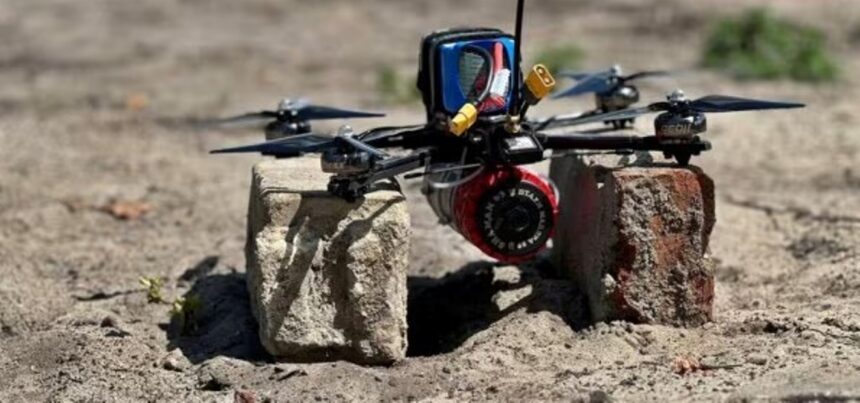FPV drones Ukraine Russia attack: The first-person view drones were reportedly first smuggled to Russia, where they were placed in “mobile wooden houses”. They struck regions nearly 4,000 km from the Ukraine-Russia border.
FPV drones Ukraine Russia attack: A Ukrainian drone attack on Russia destroyed more than 40 planes on Sunday (June 1), marking the deepest strikes in Russian territory since the conflict began in February 2022.
The attack was carried out just a day before the two countries’ representatives were to meet in Istanbul for peace talks. In a video message, Ukrainian President Volodymyr Zelenskyy said that “Operation Spider’s Web” was planned over 18 months, and that they only targeted military facilities with the help of 117 drones. Several sources have said that first-person view (FPV) drones were used.
According to Associated Press, the FPV drones were first smuggled to Russia, where they were placed in “mobile wooden houses”. They were hidden under the roofs of houses, which were remotely opened, and the drones then flew to hit their targets. The Russian Defence Ministry confirmed attacks on five locations, including in the country’s far east, which is more than 4,000 kilometres from Ukraine.
What are FPV drones?
First-person view means that a person piloting a drone can see what the drone sees, through a camera attached to its body. The live video can be seen through specialised goggles, or on smartphones and other kinds of screens, and the drone can be manoeuvred remotely. Such drones are also used in filming and other non-defence purposes.
According to the European Union Aviation Safety Agency, one major challenge is that the drones’ movement through their surroundings cannot be seen by the drone operator. This can limit situational awareness and may lead to disorientation. At times, another person, a visual observer, may be needed to guide the person controlling the drone.
Before FPV drones are deployed, a reconnaissance drone with a larger range first goes to survey the area and zero in on a specific region that needs to be targeted. FPV drones have a much smaller range, of a few kilometres.
What makes FPV drones useful in combat?
The key advantages are cost and deep strike capabilities while remaining largely undetected. A Reuters report estimated that the total cost of one such drone equipped with a payload (say, an explosive device) can be as little as $500 (around Rs 42,000). Given the significantly higher average costs of more conventional artillery systems, they make attractive alternatives.
“The tiny, inexpensive FPV (first-person view) drone has proved to be one of the most potent weapons in this war, where conventional warplanes are relatively rare because of a dense concentration of anti-aircraft systems near front lines,” the report added.
Even beyond Ukraine and Russia, drones are increasingly being used during conflicts because they minimise the risk to human life by reducing the number of boots on the ground. Technological developments have made them much cheaper over time, while maintaining and even improving on precision. All major defence powers have unmanned aerial vehicles in their arsenal, be it Israel’s “kamikaze” HAROP drones or Iran’s Shahed drones.
Has Ukraine used FPV drones before?
Ukraine has been using FPVs against Russia for some time. A November 2023 Reuters report said, “The use of agile First Person View (FPV) drones in battle has been one of the most successful of the various low-cost strategies Ukraine has used to defend itself from a full-scale invasion by Russia, its much richer and more powerful neighbour.” Therefore, it is also a part of an attrition strategy.
Both countries have since increased the production of indigenous drones. A NATO official told Foreign Policy in 2024 that more than two-thirds of the Russian tanks that Ukraine’s military had destroyed in recent months were thanks to FPV drones. Forbes reported that Ukrainian makers Vyriy Drone officially handed over the first batch of 1,000 “all-Ukrainian” FPV drones in March this year. Ukraine is also on course to produce over four million drones this year, the report added.
Domestic capabilities matter from the perspective of protecting a country’s defence system from external shifts. For example, many of the chips used in these drones come from China, which has occasionally threatened export controls when it comes to Ukraine.
A report from the think tank Center for Strategic & International Studies last year said that China is the “undisputed leader in commercial drone production”. It added, “The DJI Technology Company, a Chinese company and the world’s largest commercial drone manufacturer, holds a remarkable 90 percent share of the U.S. commercial drone market and 80 percent of the global consumer drone market. China also leads in the production of essential drone components, such as small lithium-ion batteries, with Contemporary Amperex Technology Company, Limited, being the largest battery maker by capacity.”
